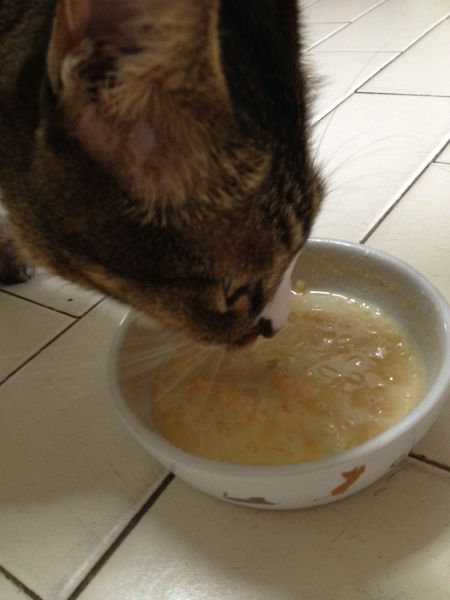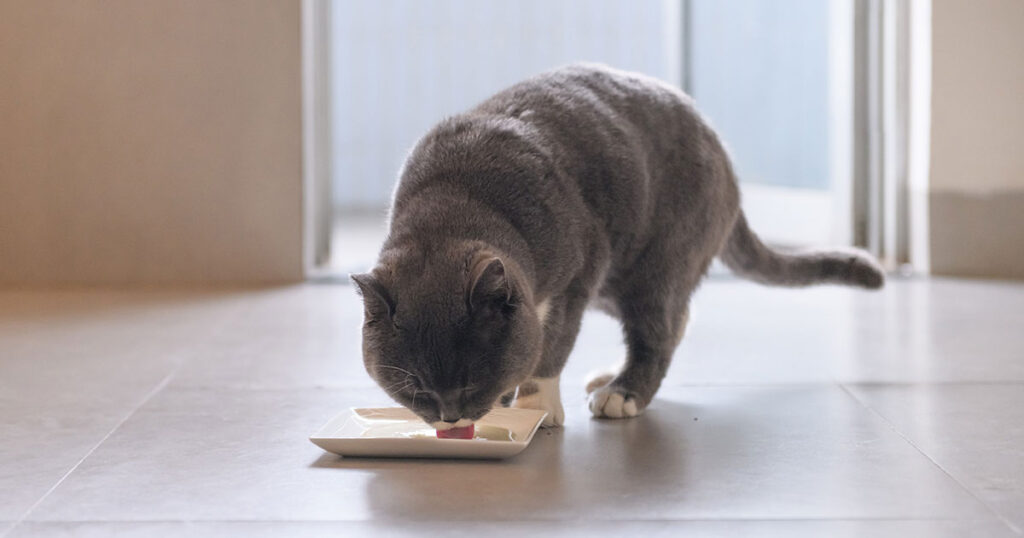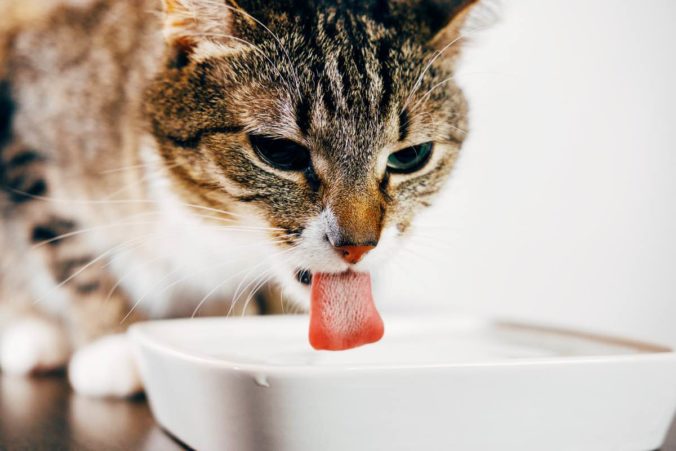Just like the human body, approximately two-thirds of the feline system is made up of water.
Cats require water for bodily functions such as digestion, waste removal, dissolving minerals, lubricating joints, and transporting blood and oxygen to body organs.
According to WebMD, cats need 3.5-4.5 ounces of water per pound of body weight per day.
When it comes to drinking water, our feline friends score terribly. Most of them have a low thirst drive meaning they don’t feel like drinking up often.
The fact that they can concentrate their urine doesn’t help either.
Because of these reasons, cats are prone to dehydration which may lead to kidney disease, bladder problems, tumors, urethral blockages, and bladder stones.
Knowing this, what can you do to encourage your cat to drink up?
More specifically, how do you hydrate a cat that won’t drink water?
We have a few suggestions that can help.
Why Your Cat Doesn’t Drink Water
Before you dip into your bag of cat tricks, it would be prudent to know the reason your cat doesn’t drink water in the first place.
There are many reasons for this:
A. Dirty Water Bowl and Water
The same way a cat won’t use a dirty litter box, she is less likely to drink water from a dirty water bowl. These creatures are incredibly appalled by dirt and its relatives.
You may want to clean the bowl and add a fresh batch of water to see if there will be any change.
B. Underlying Diseases
When you are unwell, the last thing in your mind is to drink water. The same goes for your cat.
If she’s suffering from liver disease and endocrine issues, her thirst drive will dip.
Kidney disease can cause the cat to drink up more at first. However, as it progresses, it will cause her to stop drinking. This rings true for cancer as well.
If your kitty is sick, he needs medical help.
C. Discomfort
Cats are incredibly choosy about everything. They may prefer warm water over cold.
Sometimes plastic dishes don’t work. Certain water bowls hurt their whiskers causing discomfort.
Try different bowls sizes, locations, and sizes of the water bowl. Things might change.
Tips and Tricks to Hydrate A Cat That Won’t Drink Water

1. Moist Diet
The easiest and most effective way to add some water into your cat’s body is to ditch dry food and use wet food instead.
Wet food is pleasantly high in moisture compared to dry food. It will introduce water to the cat’s system with little effort.
If your cat is on kibble, making the switch can seem difficult. You will have to cook food for the cat, buy canned food, offer yogurt, and other moist foods.
Lucky for you, there are a gazillion options to choose from. Find out what your cat likes and focus your energies there.
As long as she gets a balanced diet, she’ll be healthy and happy. Just make sure to make the switch slowly and carefully.
2. Add Water To Dry Food
Some cats plainly resist moist food no matter what. Additionally, some diets are only available in a dry form.
If you must use kibble, add some water to moisturize it. Sprinkle clean temperature water over it.
Start with a small amount such as a teaspoon and work your way up to get the cat accustomed to the changes.
After adding water to her food, let it sit for a couple of minutes so it can soak through.
If water isn’t working, switch it up for chicken or tuna broth. You may mix canned and dry food as well.
3. Low-Sodium Chicken Or Tuna Broth

Speaking of broth, you can also utilize it solely to rehydrate your cat.
For one, it is tasty. It has a chicken or tuna flavor that cats cannot resist.
Secondly, the broth is guaranteed to rehydrate your kitty. Most of it is water anyways. A little goes a long way in adding moisture to the kitty’s body.
Perhaps the most important benefit of broth is its endless bounty of essential minerals and vitamins.
The long cooking process extracts a ton of nutrients such as collagen, calcium, and marrow from the bones.
These strengthen the cat’s immune system, help detox her liver, aid in digestion, support joint health, and boost skin and coat health.
When using broth for cats, ensure it is low in sodium. Not only does salt cause dehydration, but it can also be toxic in large amounts.
Plus, cats could care less about salty foods. You also want to make sure that the broth doesn’t have garlic and onions or any toxic ingredient.
4. Add Flavor to The Water
To be honest, water is bland. It has no taste whatsoever.
Even cats know this to be true. If you make the water a little tasty for her, she may just be motivated to drink up.
Humans add lemon slices, strawberries, and other fruits to flavor their water.
We also add juices, broths, and make the water bubbly. If your kitty’s dislike for water is based on its taste (or lack thereof), sprinkle bone broth and see if she will take it.
If you have no chicken broth, extract some liquid from the tuna can and use it instead.
Sardine juice also works great as does clam juice. Ensure that tuna or sardine juice is canned in spring water.
As usual, use unsalted broths and juices only. You don’t want to introduce toxins to the cat’s body along the hydration process.
5. Offer Tuna Or Broth Ice Cubes
Another ingenious trick to get moisture into your kitty’s system is to use chilled tuna or chicken broth ice cubes.
Some cats (not all) gravitate towards liquids with ice cubes. Oftentimes, they get fascinated by the sight of bobbing ice cubes in the water.
If yours is one of them, indulge her. Grab an ice tray and pour some unsalted chicken broth, clam juice, salmon juice, and tuna juice, and place them in the freezer.
When they are chilled, get a few of the cubes and throw them into the cat’s ice cubes.
When using ice cubes around cats, you want to make sure that they don’t ingest the actual cubes.
Doing that can cause blockages, damage teeth, affect the digestive system, and trigger brain freeze.
You simply want to chill the water and introduce cold flavor to it.
6. Small, Frequent Meals

It doesn’t seem like it but feeding your kitty small, frequent meals is bound to hydrate her more than one or two large meals.
Eating ideally prompts thirst. That’s why you tend to want more water when you eat more meals than eating none.
Your cat experiences the same. The more she eats, her thirst will go up.
Needless to say, too many calories trigger obesity. As you offer multiple meals throughout the day, be careful to not overfeed the kitty.
Provide small yet frequent meals.
7. Get The Water Moving
Lastly, moving water can also encourage a cat to drink.
Felines naturally have a dislike for standing water. They prefer moving water like that running from a tap or a fountain.
Standing water is a breeding ground for insects and microorganisms anyway.
If you can get a cat water fountain, that can help. You can also open the water tap and invite the cat to come around and drink.
Other things like changing the material of the bowl, placing it in different locations, and filling it to the brim can also help things.
Closing Thoughts
Cats need water to survive and stay healthy.
However, they are unaware of this. Many of them would rather die than lick water from a bowl.
If you own such a cat, your best bet is to use creative ways to hydrate her.
You have 7 options to choose from, so no more dehydration for your kitty.

Hi! I am Eleanor Price. I started this website after my cat, Louie, almost died from a case of botulism (a type of food poisoning often caused by bacteria that grow on food items). Turned out that my cat’s diet was the problem. I have made it my duty to provide the best information and recommendations about everything cat lovers need to know about their felines’ health and wellbeing. My goal is to find the most informative content on anything feline-related and share it with fellow hardworking kitty lovers.

